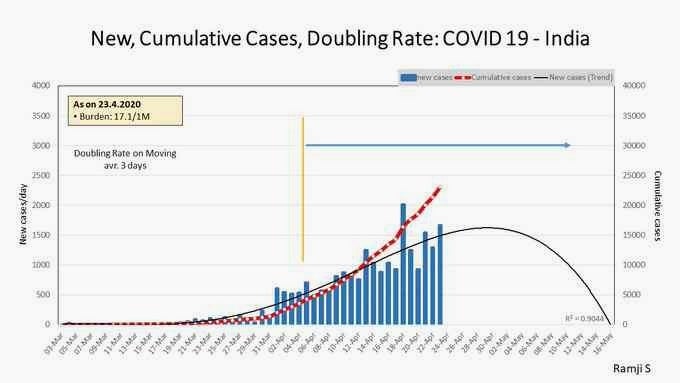It’s working… it’s not: The Indian government’s view of the coronavirus lockdown
On Friday (April 24), as part of its press briefing on the Covid-19 pandemic, the central government put out a study that painted a rather rosy picture of the manner in which the disease will play out in India. VK Paul, NITI Aayog member and head of a committee on medical management, told the media that the Narendra Modi government’s national lockdown had dramatically slowed the rate of transmission. As a result, the growth rate of new cases has slowed.


On Friday (April 24), as part of its press briefing on the Covid-19 pandemic, the central government put out a study that painted a rather rosy picture of the manner in which the disease will play out in India. VK Paul, NITI Aayog member and head of a committee on medical management, told the media that the Narendra Modi government’s national lockdown had dramatically slowed the rate of transmission. As a result, the growth rate of new cases has slowed.
The study went on to make a remarkable projection. It showed that the number of new cases would start dropping sharply after May 3. By May 16, India would have no new cases.

However, the union government provided little context to explain how it has arrived at this projection. To make matters worse, an independent member of the same committee itself told The Hindu newspaper that the projection seems “highly unlikely.”
In fact, this optimistic projection contradicts other data put out by the union government itself. In a meeting with state chief secretaries on Sunday (April 26), the government projected that India would hit 2.74 crore cases by August 15, reported The Indian Express newspaper—a massive increase from the 31,332 today. Similarly, the government on April 22 predicted that Mumbai city would see a huge spike in cases by May 15, with a steep day-on-day increase of 20%.
At around the same time, the Indian Council of Medical Research has also published a paper that calls for a sharp increase in testing—yet another sign that New Delhi thinks India is going to see an increase in cases.
Confusion at the top
This data mismatch highlights some important gaps in how India is dealing with the crisis. Most obviously, this wide diversion over projections within the government does not present a very reassuring picture of how the pandemic is being handled at the top. To make matters worse, the government has not bothered to explain how it reached its projections, leaving even more confusion.
Some of mismatch in the data can be pinned on the politics of public perception. The government’s projection that new cases would end by May 16 was accompanied by self-congratulatory messages that this had happened due to the Modi government’s decision to impose a complete lockdown. Yet, in an attempt to get states to enforce further lockdown measures, New Delhi is also projecting a contrary scenario.
India’s lockdown has been the harshest in the world, made worse by the fact that it was accompanied by little planning and foresight. Not only does this cause immense human suffering, it weakens the hand of the Indian state going forward on containment measures. The fact that the Modi government is simultaneously projecting an end to new cases by May 16 and communicating that containment measures will continue for a long time makes it difficult for the states to convince residents to follow those restrictions.
It is now increasingly becoming apparent that the fight against coronavirus will be measured in years, not weeks. In such a scenario, it is irresponsible to push data that seem to be short-term public-relations triumphs while at the same time weakening trust in containment measures.
This article first appeared on Scroll.in. We welcome your comments at [email protected].